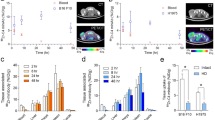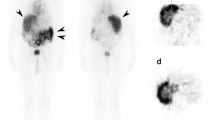Summary
The targeting of monoclonal antibodies to human tumor xenografts in nude mice was investigated by analysis of the cellular distribution of two radioiodinated monoclonal antibodies, B6.2 and B72.3, which recognize different tumor-associated antigens. The time course of distribution of each antibody within Clouser human mammary carcinoma (B6.2 positive, B72.3 negative) and LS174T human colorectal carcinoma (B6.2 positive, B72.3 positive) following i. v. injections was compared using autoradiographic techniques, which were also used to determine the pattern of binding after in vitro incubation with radiolabeled antibody. Both in vivo and in vitro localization of 125I-B72.3 in LS174T were characterized by the binding of antibody to antigen-rich mucin globules. In contrast, in vivo localization of B6.2 was restricted to groups of cells in well vascularized regions. Thus, the in vivo accumulations of B6.2 and B72.3 although quantitatively similar showed very different spatial distributions within LS174T tumors. The in vivo binding of B6.2 in Clouser tumors was restricted to small clusters of cells scattered fairly evenly throughout the tumor. There was no evidence for the presence of such antigen-rich foci after in vitro incubation of tumor sections with B6.2 suggesting that heterogeneity of regional uptake may be due to differences in antibody delivery. This type of information may provide a rational basis for the selection of appropriate therapeutic isotopes for radioimmunotherapy studies using these and other tumor models.
Similar content being viewed by others
References
Bale WF, Contreras MA, Grady ED (1980) Factors influencing localization of labeled antibodies in tumors. Cancer Res 40:2965
Ballou B, Jaffe R, Taylor RJ, Solter D, Hakala TR (1984) Tumor radioimmunolocation: differential antibody retention by antigenic normal tissue and tumor. J Immunol 132:2111
Bateman WJ, Vaughan ATM, Brown G (1983) Tumor localization of 211At-labeled monoclonal antibody to a subcutaneous human heterograft in the nude mouse II. Int J Nucl Med Biol 10:241
Brabon AB, Williams JF, Cardiff RD (1984) A monoclonal antibody to a human breast carcinoma protein released in response to estrogen. Cancer Res 44:2704
Brown BA, Comeau RD, Jones PL, Liberatore FA, Neacy WP, Sands H, Gallagher BM (1985) Comparison of the pharmacokinetics of I-125 and In-111 labeled intact and proteolytic fragments of a monoclonal antibody. J Nucl Med 26:p 45
Burchiel S (1986) Purification and analysis of monoclonal antibodies by high performance liquid chromatography. In: Methods in enzymology, Immunochemical techniques: Part I. Academic Press NY in press
Colcher D, Horan Hand P, Nuti M, Schlom J (1983) A spectrum of monoclonal antibodies reactive with human mammary tumor cells. Proc Natl Acad Sci 78:3199
Colcher D, Zalutsky M, Kaplan W, Kufe D, Austin F, Schlom J (1983) Radiolocalization of human mammary tumors in athymic mice by a monoclonal antibody. Cancer Res 43:736
Dvorak HF, Dvorak AM (1982) Immunohistochemical characterization of inflammatory cells that infiltrate tumors. In: Tumor immunology in prognosis. Marcel Dekker, NY p 279
Dvorak HF, Dickerson GR, Dvorak AM, Manseau EJ, Pyne K (1981) Human breast carcinoma: fibrin deposits and desmoplasia. Inflammatory cell type and distribution. Microvasculature and infarction. J Natl Cancer Inst 67:335
Fidler IJ, Gersten DM, Hart IR (1978) The biology of cancer invasion and metastasis. Adv Cancer Res 28:149
Foon KA, Bernhard MI, Oldham RK (1982) Monoclonal antibody therapy: assessment by animal tumor models. J Biol Response Mod 1:277
Gallagher BM (1983) Monoclonal antibodies: the design of appropriate carrier and evaluation systems. In: Lambrecht RM, Eckelman WC (eds) Animal models in radiotracer design. Springer-Verlag, p 61
Hand HP, Colcher D, Wunderlich D, Nuti M, Teramoto YA, Kufe D, Schlom J (1983) Rational basis for the diagnostic, prognostic, and therapeutic utility of monoclonal antibodies in the management of human breast cancer. In: Rational basis for chemotherapy, UCLA symposia on molecular and cellular biology, vol. 1. Alan Liss, Inc. p 315
Herlyn D, Powe J, Alavi A, Mattis JA, Herlyn M, Ernst C, Vaum R, Koprowski H (1983) Radioimmunodetection of human tumor xenografts by monoclonal antibodies. Cancer Res 43:2731
Larson SM, Brown JP, Wright PW, Carrasquillo JA, Hellström I, Hellström KE (1983) Imaging of melanoma with I-131-labeled monoclonal antibodies. J Nucl Med 24:123
Larson SM, Carrasquillo JA, Krohn KA, Brown JP, McGuffin RW, Fereas JM, Graham MM, Hill LD, Beaumier PL, Hellström KE, Hellström I (1983) Localization of 131I-labeled p97-specific Fab fragments in human melanoma as a basis for radiotherapy. J Clin Invest 72:2101
Moshakis V, McIlhinney RAJ, Raghavan D, Neville AM (1981) Localization of human tumor xenografts after i. v. administration of radiolabeled monoclonal antibodies. Br J Cancer 44:91
Pimm MV, Armitage NC, Perkins AC, Smith W, Baldwin RW (1985) Localization of an anti-CEA monoclonal antibody in colorectal carcinoma xenografts. Cancer Immunol Immunother 19:8
Sands H, Shah SA, Jones PL, Neacy W, Gallagher BM (1985) Non-immunological factors affecting the localization of monoclonal antibodies in xenografts of human breast and colon tumors. In: Proc int workshop on monoclonal antibodies and breast cancer. Martinus Nighoff, Boston, p 303
Sands H, Shah SA, Gallagher BM (1985) Vascular volume and permeability of human and murine tumors grown in athymic mice. Cancer Lett 27:15
Stramignoni D, Bowen R, Atkinson BF, Scholm J (1983) Differential reactivity of monoclonal antibodies with human colon adenocarcinomas and adenomas. Int J Cancer 31:543
Thorpe PE, Edwards DC, Davies AJS, Ross WCJ (1982) Monoclonal antibody-toxin conjugates: aiming the magic bullet. In: Monoclonal antibodies in clinical medicine. Academic Press, London, p 167
Tom BH, Rutzky LP, Jakstys MM, Ryoichi O, Kaye CI, Kahan, BD (1976) Human colonic adenocarcinoma cells I. Establishment and description of a new line. In Vitro 12:180
Zalcberg JR, Thompson CH, Lichtenstein M, Andrews J, McKenzie FC (1983) Localization of human colorectal tumor xenografts in nude mouse with the use of radiolabeled monoclonal antibody. J Natl Cancer Inst 71:801
Author information
Authors and Affiliations
Rights and permissions
About this article
Cite this article
Jones, P.L., Gallagher, B.M. & Sands, H. Autoradiographic analysis of monoclonal antibody distribution in human colon and breast tumor xenografts. Cancer Immunol Immunother 22, 139–143 (1986). https://doi.org/10.1007/BF00199128
Received:
Accepted:
Issue Date:
DOI: https://doi.org/10.1007/BF00199128




